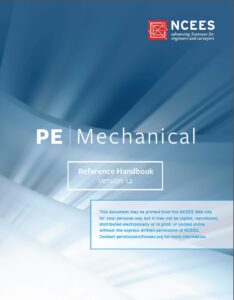Principles and Practice of Engineering PE Mechanical Reference
Principles and Practice of Engineering PE Mechanical Reference
the Principles and Practice of Engineering (PE) Mechanical exam will be computer-based, and the PE Mechanical Reference Handbook is the only resource material you can use during the exam. Reviewing it before exam day will help you become familiar with the charts, formulas, tables, and other reference information provided. You will not allowed to bring your personal copy of the PE Mechanical Reference Handbook into the exam room. Instead, the computer-based exam will include a PDF version of the handbook for your use. No printed copies of the handbook will be allowed in the exam room.
You Can also Read FE Mechanical Practice Problems
The PDF version of the PE Mechanical Reference Handbook that you use on exam day will be very similar to this one. However, pages not needed to solve exam questions—such as the cover and introductory material—will not be included in the exam version. In addition, NCEES will periodically revise and update the handbook, and each PE Mechanical exam will be administered using the version of the handbook in effect on the date the exam is given.
Content
- Cover and copyright
![PE Mechanical Reference]()
- preface
- contents
- Engineering Terms and Symbols
- Elements of Machine Design Methodologies
- Density, Specific Weight, and Specific Gravity
- Definitions
- Thermal Diffusivity (Single-Effect Absorption Cycle, Water-Cooled Condensers, Refrigeration Evaporator: Top Feed Versus Bottom-Feed, Liquid Overfeed Systems, Comparative Refrigerant Performance Per Ton of Refrigeration, Refrigerant R-22, Refrigerant R-134a, Thermophysical Properties of Refrigerants, Refrigerant Safety, Refrigeration Properties of Foods.)
- Feedwater Heaters (Human Cooling Loads, Electric Lighting, Heat Gain from Kitchen Equipment, Heat Gain Calculations Using Standard Air and Water Values, Fenestration, Thermal Conductivity of Soils-Factors for Fenestration,Design U-Factors of Swinging Doors , Pipe and Duct Insulation)
- Psychrometric Properties
- Thermal Cycles
- Human Cooling Loads
- General Information
- Terminology
Download


Comments are closed.